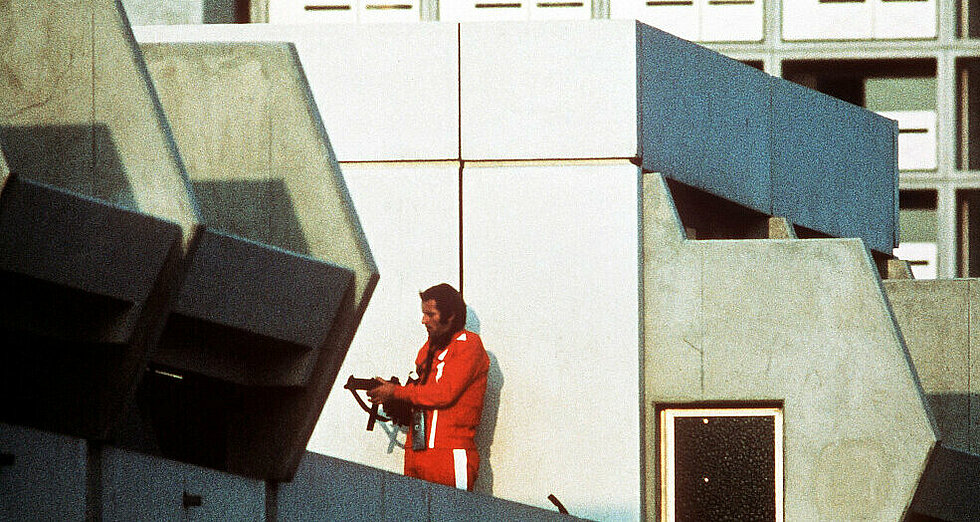The 1972 Munich attackers did not see any television images
The research project on Re-Examining the Attack at the 1972 Olympics has examined sources that dispel a popular myth: Contrary to long-held assumptions, the terrorists in the Olympic Village were not able to follow on television how police officers were positioning themselves on the rooftops.
Men in tracksuits, heavily armed, could be seen climbing onto the rooftops of the Olympic Village with the apartment at Connollystraße 31 in their sights, where Palestinian terrorists were holding Israeli athletes hostage. These scenes number among the most iconic images of the September 5, 1972 attack at the Munich Olympic Games, and were broadcast on television all around the world. Most recently, the Oscar-nominated feature film September 5, awarded with the German Film Award Lola, impressively depicted the role of the ABC journalists who reported live on the scene and, in doing so, helped the terrorists attain global attention.
The film also featured a notion that has figured large in the popular narratives of the attack over the past several decades: that the terrorists could follow the same images that other viewers were watching on live television. As the legend goes, the perpetrators were able to observe the actions of the police as they surrounded them, and that the police found out about this and decided to withdraw and call off the rescue attempt.
The research project on “Re-Examining the Attack at the 1972 Olympics”, which includes an international commission of historians along with researchers from the Leibniz Institute for Contemporary History (IfZ), has now revealed the fact that there was no such television in the Connollystraße 31 apartment in the first place. This was corroborated by several sources analyzed by IfZ historians Adrian Hänni, Dominik Aufleger and Lutz Kreller. Link to the Hänni/Aufleger/Kreller research report
While television sets could in fact be found within the Olympic Village, they were primarily located in common areas and were not part of the standard fixtures in the men’s bedrooms and living rooms. The blueprints of the architects who designed the Olympic Village indicate that no television connections were indeed to be installed at Connollystraße 31. And police sources are even clearer on the matter: The numerous photos of the crime scene taken by forensics teams reveal no television or radio sets. The police department’s 25-page crime scene report, moreover, meticulously lists all the objects in the apartment, ranging from radiators, electrical sockets, cupboards, and bedside tables to reading lamps, shaving brushes, apples, and potato chips. Here again, there is no mention of any televisions or radios.
So how did this myth come about? The researchers uncovered several indications that could shed light on the matter: For one thing, other athletes who were following the events live in front of television sets in the Olympic Village apparently wondered if the terrorists could in fact see the same things that they were watching. In addition, several ABC journalists reported that the police had stormed into their control room, demanding that they switch off their cameras, while at around the very same time, the policemen were withdrawn from the rooftops. This was a particularly dramatic moment in the film September 5.
Using several police sources, the researchers have now demonstrated that the simultaneity of the developments was purely coincidental. The police had in fact repeatedly requested that ABC switch off their cameras over the course of several hours. Any live audience during such a difficult operation was certainly not in the interest of the police. The withdrawal of the police from the rooftops had, however, other reasons: At that time, Federal Interior Minister Hans-Dietrich Genscher, accompanied by Munich Police Chief Manfred Schreiber and Bavarian Interior Minister Bruno Merk, were negotiating with the terrorists outside the apartment once again. As radio transmissions revealed, the police was afraid that the perpetrators could spot the storm squads on the rooftops, which could have escalated the situation further and placed the politicians’ lives in danger.
“The International Commission of Historians has been taking its task of comprehensively investigating every detail of the brutal terrorist attack of September 1972 very seriously,” Professor Michael Brenner, member of commission explained. “The result of our thorough examination of all items in the rooms of the Israeli accommodation clearly shows that many assumptions, long held in previous research and in public opinion, now need to be revised.”
Achieving a precise reconstruction of the events of September 5 is one of the main focuses of the research project. As Professor Wirsching added: “The sequence of events of September 5 and 6 must be examined in detail. The errors made by German security agencies and politicians, as well as the botched police operation in Munich and Fürstenfeldbruck, which ended with the deaths of all the hostages and a German police officer, need to be rigorously analyzed.”
Beginning in September 2023, an eight-member commission of historians and the Leibniz Institute for Contemporary History have been researching the attack at the 1972 Olympics, its background and its aftermath. The project was commissioned by the Federal Ministry of the Interior and its results will be included in a report to the ministry as well as in an edited volume. The project will run through the end of 2026. Visit our website to find out more about the key research questions.

Press Contact
Tina Angerer Tel.: +49 89 4111 501 14 Mail: angerer@ifz-muenchen.de